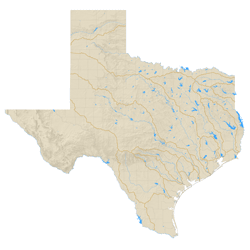Texas Lakes & Reservoirs
History of Reservoir Construction in Texas
 Reservoirs are important for providing water supplies, particularly in a state with such variable streamflow. More than half of the available surface water in the state is from reservoirs (8.9 million acre-feet per year for reservoirs out of a total of 13.3 million acre-feet per year). Reservoirs are able to capture and store flood-waters for use during times of drought when the rivers are low or dry. In fact, many of the state's major reservoirs were constructed principally for flood control, with water supply as a secondary benefit before 1950s. However, Texan lately realized that water supply are equally important as flood control. Many water supply reservoirs with flood control function as well were constructed after 1950s mega drought. The history of construction of the state's major reservoirs illustrates that there was a flurry of activity in the 1960s and 1970s, but there has been a dramatic decrease in reservoir construction since that time (see Figure 3.2 in 2007 State Water Plan).
Reservoirs are important for providing water supplies, particularly in a state with such variable streamflow. More than half of the available surface water in the state is from reservoirs (8.9 million acre-feet per year for reservoirs out of a total of 13.3 million acre-feet per year). Reservoirs are able to capture and store flood-waters for use during times of drought when the rivers are low or dry. In fact, many of the state's major reservoirs were constructed principally for flood control, with water supply as a secondary benefit before 1950s. However, Texan lately realized that water supply are equally important as flood control. Many water supply reservoirs with flood control function as well were constructed after 1950s mega drought. The history of construction of the state's major reservoirs illustrates that there was a flurry of activity in the 1960s and 1970s, but there has been a dramatic decrease in reservoir construction since that time (see Figure 3.2 in 2007 State Water Plan).
In the 1984 State Water Plan there were 44 reservoirs proposed to meet water supply needs. In the 2002 State Water Plan, there were eight major and ten minor reservoirs recommended; in the 2007 State Water Plan there are 14 major and two minor reservoirs recommended in this state water plan (see Chapter 10, section 10.2.2 in 2007 State Water Plan). The slowdown in reservoir construction is due, in part, to the fact that there remain very few viable sites for new major reservoirs, permits are much more difficult to obtain due primarily to environmental concerns, and the cost of construction has gone up faster than the rate of inflation.
Original Reservoir Survey Sheets

Reservoir Basin Plates - Map Series - Displays map and information on individual reservoirs or lakes, and their associated dams.